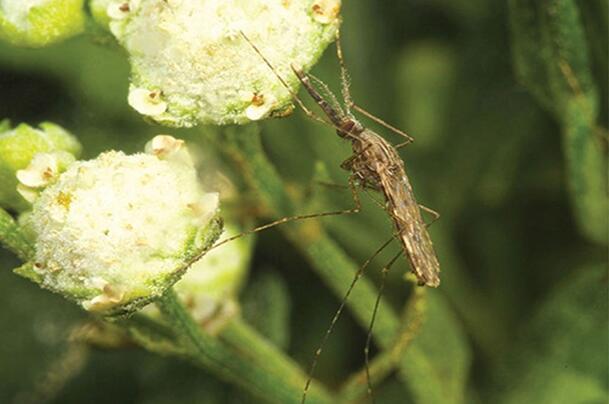Plos One:一种外来入侵植物在东非竟成疟疾的帮凶
没有血液作为食物的时候,吸食外来入侵植物银胶菊花蜜的蚊子,与依靠本地植物汁液为生的同类相比寿命可延长一倍。

一只雌性按蚊(Anopheles按蚊属)落在在银胶菊花朵上。图片来源:Robert Copeland/ICIPE
由于一种入侵植物,东非抗击疟疾的战斗可能遭遇挫折。
原产美洲的银胶菊(Parthenium hysterophorus),也叫圣马利亚菊,正在非洲东部大肆蔓延。这种菊含有高毒性物质银胶菊素,能在人体上导致皮炎、花粉症和哮喘。这种物质对牲畜同样有害,并且当牲畜吃了这种植物后,此物质还会污染肉和奶。
近年来,人们越来越确信银胶菊的花对传播疟疾的雌性冈比亚按蚊(Anopheles gambiae)有着极大的吸引力。但最近,研究者还发现,当蚊子找不到血源的时候,似乎可以靠这种植物的花蜜活下来。
在肯尼亚首都内罗毕的国际昆虫生理生态研究中心(InternationalCentre of Insect Physiology and Ecology)任职的Baldwyn Torto和同事们取了一些一日龄的蚊子,将它们养在一个能接触到银胶菊、蓖麻(Ricinus communis)或鬼针草(Biden spilosa)(一种在肯尼亚当作蔬菜的植物)三者之一的笼子里。另一些蚊子则可以接触到糖水或蒸馏水。
血液的替代品
用糖水喂养的蚊子活得最好,超过60%在两周后仍存活。只用蒸馏水喂养的蚊子在一周内全部死亡。植物喂养的蚊子两周后的存活率,蓖麻有45%,银胶菊有30%,鬼针草仅有10%多一点。
这些数据表明,如果银胶菊继续扩散,代替了鬼针草,那么蚊子将会更容易在血液大餐间长时间的斋戒间隔中存活。
更值得注意的是,用银胶菊喂养的蚊子比用其他植物喂养的储藏了更多的脂肪。脂肪含有大量的能量,且对昆虫的许多功能有关键性作用,Torto说。“举例说,脂肪与蚊子的胚胎发育以及生殖能力就有很大的联系。”他说。
有趣的是,研究显示蚊子体内银胶菊素的影响并不像在人类和牲畜身上观察到的那么严重。研究者表示,冈比亚按蚊的雌性能够抵抗银胶菊素的毒效,还可能将这种化合物从体内排泄干净。
对疟疾的影响
但未参加该研究的肯尼亚医学研究中心(KenyaMedical Research Institute)的疟疾研究者CharlesMbogo指出,仍有些问题需要解答。用银胶菊喂养的蚊子会变得更容易被疟原虫感染吗?他提出疑问。还有,“银胶菊的花蜜会增加人类被咬的频率,并增加传播几率吗?”
内罗毕非洲人口与健康研究中心的健康挑战与制度计划(healthChallenges and Systems Program at the African Population & Health ResearchCenter in Nairobi)的领导者CollinsOuma,也同意这个看法。根除银胶菊不应该成为现在的首要目标,因为“我们更想知道感染疟原虫的同时又食用银胶菊提取物会对蚊子造成怎样的影响”,他说。“这个很重要,因为蚊子被疟原虫感染后会降低自己的寿命和存活率。”
这正是Torto和他的同事们想要找出的答案。他们正在评估银胶菊素对已被疟原虫感染的蚊子的有何影响。
原文链接:
The Invasive American Weed Parthenium hysterophorus Can Negatively Impact Malaria Control in Africa
原文摘要:
The direct negative effects of invasive plant species on agriculture and biodiversity are well known, but their indirect effects on human health, and particularly their interactions with disease-transmitting vectors, remains poorly explored. This study sought to investigate the impact of the invasive Neotropical weed Parthenium hysterophorus and its toxins on the survival and energy reserves of the malaria vector Anopheles gambiae. In this study, we compared the fitness of An. gambiae fed on three differentially attractive mosquito host plants and their major toxins; the highly aggressive invasive Neotropical weed Parthenium hysterophorus (Asteraceae) in East Africa and two other adapted weeds, Ricinus communis (Euphorbiaceae) and Bidens pilosa (Asteraceae). Our results showed that female An. gambiae fitness varied with host plants as females survived better and accumulated substantial energy reserves when fed on P.hysterophorus and R. communis compared to B. pilosa. Females tolerated parthenin and 1-phenylhepta-1, 3, 5-triyne, the toxins produced by P. hysterophorus and B. pilosa, respectively, but not ricinine produced by R. communis. Given that invasive plants like P. hysterophorus can suppress or even replace less competitive species that might be less suitable host-plants for arthropod disease vectors, the spread of invasive plants could lead to higher disease transmission. Parthenium hysterophorus represents a possible indirect effect of invasive plants on human health, which underpins the need to include an additional health dimension in risk-analysis modelling for invasive plants.
DOI: 10.1371/journal.pone.0137836
作者:Baldwyn Torto

